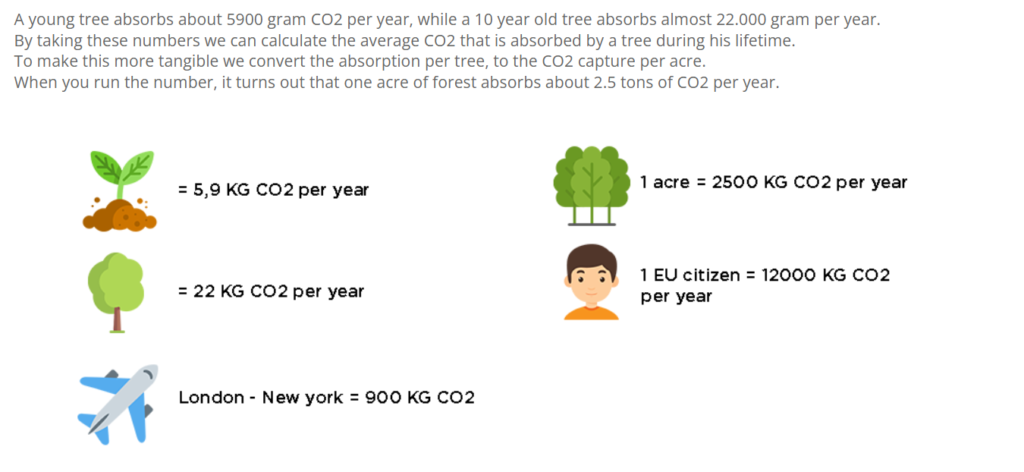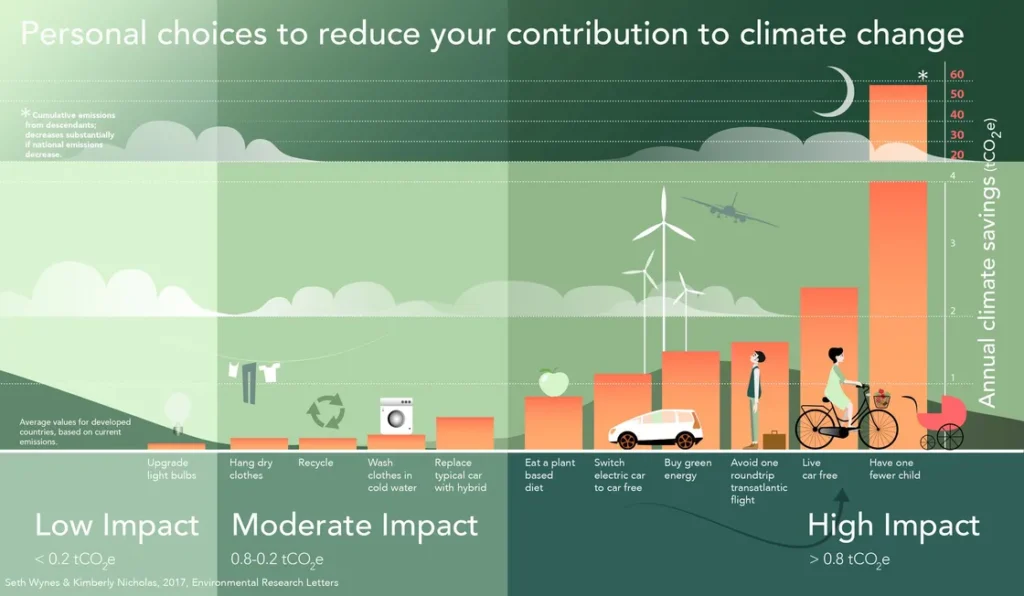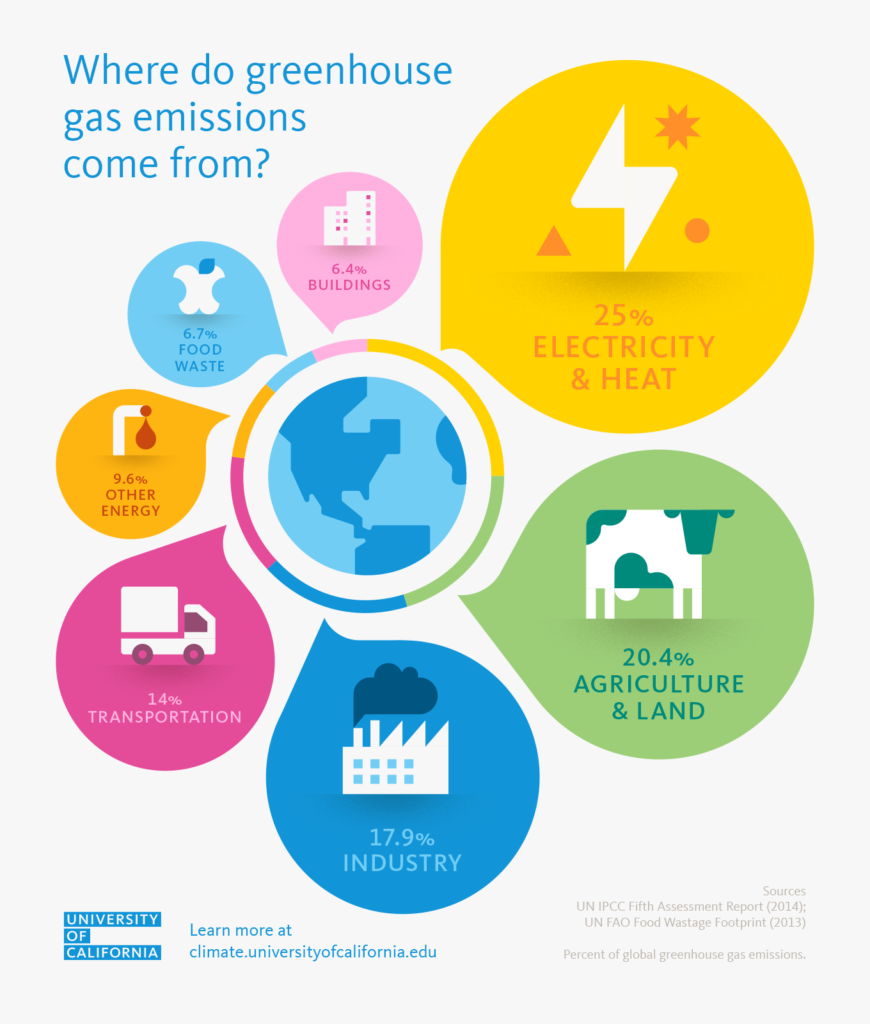While common environmental advice like planting trees, recycling, and switching off lights are important, their impact is often overstated.
To truly make a significant difference in mitigating climate change, more profound lifestyle changes are needed.
This article examines the real numerical impact of these commonly advised measures and explores more effective actions individuals can take to protect our planet.
The Limited Impact of Common Environmental Measures

Image source: Carbon Pirates
a. Planting Trees
Planting trees is often hailed as a solution to combat climate change, but its effectiveness is limited by time and scale.
According to the U.S. Department of Energy, a single mature tree can absorb about 48 pounds (approximately 22 kilograms) of CO2 per year. However, it takes decades for a tree to reach full maturity and provide maximum benefits.
Numerical Impact: To offset the annual carbon footprint of an average American (around 16 tons of CO2), approximately 730 mature trees are needed. This is far beyond the capacity of individual efforts.
Note: Trees, however, play a crucial role in mitigating urban heat islands by providing shade and cooling through evapotranspiration.
According to research, urban areas with a tree canopy cover of at least 40% can reduce temperatures by 1-5°C (2-9°F).
This cooling effect is most effective when trees are strategically planted along streets, in parks, and around buildings, requiring approximately 10-15 trees per 1,000 square feet to achieve significant temperature reductions (Urban Heat Island Report).
b. Recycling
Recycling helps reduce waste and conserve resources, but its direct impact on reducing carbon emissions is relatively small.
The Environmental Protection Agency (EPA) estimates that recycling one ton of mixed recyclables can save approximately 2.5 tons of CO2.
Numerical Impact: While beneficial, recycling alone cannot significantly reduce individual carbon footprints, which are often in the range of 10-20 tons of CO2 per year in developed countries.
c. Switching Off Lights
Turning off lights when not in use is a good habit, but its impact is minimal in the grand scheme of things.
The average light bulb emits about 0.45 pounds (0.2 kilograms) of CO2 per hour of use.
Numerical Impact: Switching off a light bulb for 8 hours a day can save approximately 1.6 pounds (0.73 kilograms) of CO2 per month, a negligible amount compared to total emissions.
More Effective Measures for Significant Impact

Image source: Lund University
a. Reducing Reproduction
Having one fewer child is one of the most effective ways to reduce one’s carbon footprint.
According to a study published in Environmental Research Letters, each child born in a developed country adds approximately 58.6 tons of CO2-equivalent emissions per year, considering future generations.
Numerical Impact: By choosing to have one fewer child, an individual can save a significant amount of CO2 emissions over their lifetime and beyond.
b. Avoiding Personal Cars
Transportation is a major contributor to carbon emissions.
The Union of Concerned Scientists estimates that the average gasoline car emits about 4.6 metric tons of CO2 per year.
Numerical Impact: Switching to public transportation, biking, or walking can eliminate these emissions, significantly reducing one’s carbon footprint.
c. Adopting a Plant-Based Diet
Animal agriculture is a significant source of greenhouse gases.
A study from the University of Oxford found that adopting a vegan diet can reduce an individual’s carbon footprint from food by up to 73%.
Numerical Impact: This change can save approximately 1.5 tons of CO2-equivalent emissions per person per year.
d. Limiting Air Travel
Air travel is one of the most carbon-intensive activities. A round-trip transatlantic flight emits about 1.6 tons of CO2 per passenger.
Numerical Impact: Reducing the number of flights taken can significantly lower one’s carbon footprint. Avoiding just one long-haul flight per year can make a notable difference.
e. Using Renewable Energy
Switching to renewable energy sources for home electricity can drastically reduce carbon emissions.
According to the National Renewable Energy Laboratory (NREL), renewable energy can reduce household carbon emissions by about 30%.
Numerical Impact: For a household emitting 10 tons of CO2 annually from electricity use, switching to renewable energy can save about 3 tons of CO2 per year.
Collective Action for Greater Impact

While individual actions are crucial, collective efforts and systemic changes are necessary for substantial progress:
a. Supporting Policy Changes
Advocating for and supporting policies that promote renewable energy, carbon pricing, and sustainable agriculture can lead to large-scale reductions in carbon emissions.
b. Corporate Responsibility
Encouraging businesses to adopt sustainable practices and reduce their carbon footprints is essential. Consumers can influence corporate behavior by choosing environmentally responsible products and companies.
c. Community Initiatives
Participating in and supporting community-based environmental initiatives, such as local tree-planting projects, recycling programs, and public transportation improvements, can amplify individual efforts.

Image source: World Economic Forum
While commonly advised measures like planting trees, recycling, and switching off lights are beneficial, their impact is limited when compared to more profound lifestyle changes.
By reducing reproduction, avoiding personal cars, adopting a plant-based diet, limiting air travel, and using renewable energy, individuals can make a significant difference in combating climate change.
Collective actions, policy support, and corporate responsibility are also crucial for achieving a sustainable future.

